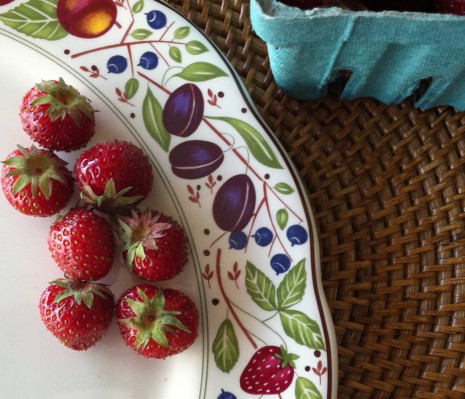STRAWBERRIES WITH MADEIRA AND ORANGE
Strawberry shortcake has its place. I’m not saying it doesn’t. But if you are inclined to take the path of least resistance, then it’s hard to beat strawberries macerated in a little sugar, orange juice, and Madeira or Sherry.
This is far from a new idea. Stephen Schmidt, culinary historian, cooking teacher, and author of a forthcoming history of American home desserts, pointed me toward the combination of orange juice and Madeira or Sherry in Fannie Farmer’s wine jellies. “It may have been popular somewhat earlier,” he explained. “Eliza Leslie flavors her 1837 calves’ feet jelly, which is basically a wine jelly, with lemon juice and Madeira.
Macerated fresh fruit was a Victorian fad borrowed from the French, he added. Sure enough, in one of Eliza Leslie’s later compilations, Miss Leslie’s New Cookery Book of 1857, you will find Strawberries in Wine; there’s no citrus, but the author does specify Madeira or Sherry. The berries are “served at parties in small glass saucers,” she noted, “heaped on the top with whipped cream, or with white ice cream.”
My grandmother used glass saucers for serving as well—they hold a puddle of winey juices very nicely—but her rationale behind macerated strawberries wasn’t a special occasion but a too-hot-to-bake day. By late June, her house would be dim and shadowy, the long windows shuttered to keep out the heat and bright shafts of sunlight. Preparations for the evening meal—a pot of snap beans set to simmer, for instance—usually began in the cool of the morning, after the breakfast things were cleared away. A “strawberry bowl,” however, was left until the drowsy afternoon. I’d be pulled away from Nancy Drew to help wash a colander full of the ripe fruit (“always leave the caps on, dear, so they don’t get waterlogged”) and pat them dry with well-worn tea towels reserved for just that purpose. Trying to copy my grandmother’s neat, economical flick of the wrist made quick work (or so I thought) of hulling.
You may wonder if a fortified wine such as Madeira or Sherry (or Port, if that’s your preference) will overpower strawberries, one of the softest, most perishable fruits, but I’m reminded of the “Nobody puts Baby in a corner” line from the movie Dirty Dancing. Although each wine adds its singular, supple balance of sweetness and acidity to the berries, the fruit not only holds its own but gains extra resonance. This is a decided plus if the weather hasn’t been co-operative; strawberries need warm sunny days and cooler nights for peak flavor and fragrance.
Strawberries aren’t often marketed under their variety names—here in the Northeast, small day-neutral Tristars, shown above, are an exception that will grace local farmers markets all summer long. In general, let aroma be your primary guide when shopping.
Whipped cream or vanilla ice cream à la Eliza Leslie are perfectly fine accompaniments to macerated strawberries, but my grandmother’s favorite embellishment was actually a exercise in household economy: leftover (i.e., slightly stale) sponge cake or pound cake, cut into fingers or cubes and toasted. The end result was modest and restrained yet completely refreshing, and afterward, everyone at the table stood up, ready for a game of cards or Parcheesi. What I realize I’m ready for, though, is a set of Victorian cut-glass saucers. And maybe some Nancy Drew.
Strawberries with Madeira and Orange
1 quart ripe strawberries
Sugar to taste
About ¼ cup orange juice, freshly squeezed if possible
About ¼ cup medium-dry Madeira or Sherry
1. Quickly rinse the strawberries and pat them dry. Hull them with a paring knife and put the whole berries (halve them if large) in a serving bowl.
2. Generously sprinkle them with sugar and gently stir in o.j. and Madeira. Refrigerate, covered, until the berries release their juices and the flavors have a chance to play well together, about 2 hours.
Posted: June 26th, 2012 under cookbooks, culinary history, summer.


